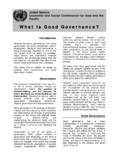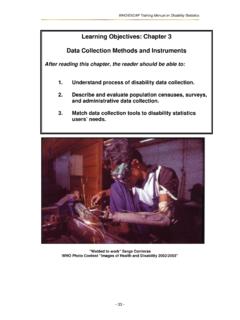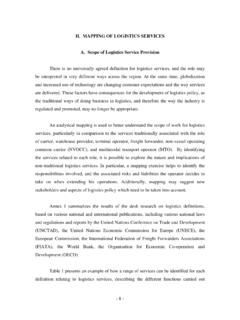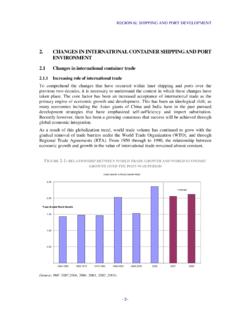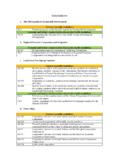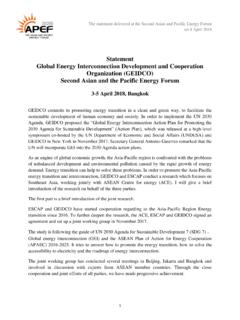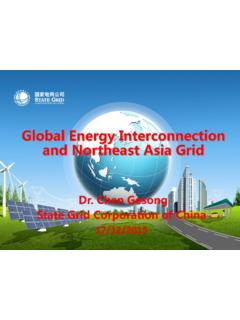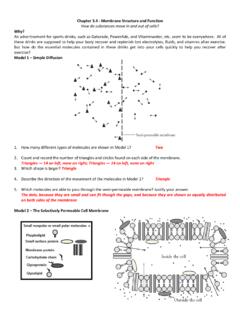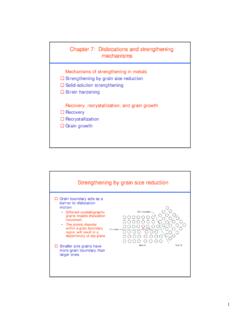Transcription of Chapter 4 Technology and Inequalities - ESCAP
1 INEQUALITY IN ASIA AND THE PACIFIC62 Chapter 4 Technology and Inequalities63 INEQUALITY IN ASIA AND THE HOW CAN Technology IMPACTINEQUALITY?The relationship between Technology and inequality ismultifaceted. Technology has enhanced productivity,accelerated economic growth, enabled knowledge andinformation sharing and increased access to basicservices. However, it has also been the cause ofinequalities. This Chapter examines the role oftechnology across the three facets of inequalitydiscussed in the previous chapters: inequality ofoutcome; inequality of opportunities; and inequality ofimpact, which is concerned with the impact ofenvironmental hazards on the most Chapter starts by underlining that digital connectivityis a core enabler of the emerging Fourth IndustrialRevolution a wave of highly disruptive innovations thatwill bring new big ideas and trigger additional layers oftechnological innovations that compel a rethink of alltraditional responses, as societies, communities and evenwhat it means to be human, is challenged.
2 These futureimpacts cannot be underestimated. While digitalinnovation and the spur of the Third IndustrialRevolution helped accelerate economic growth throughthe competitive participation of the Asia-Pacific regionin the global supply chain, a number of low-incomecountries lagged behind and did not benefit equallyfrom the digital revolution. Therefore, as frontiertechnologies go mainstream, a key policy concern giventhe speed, scale and depth of the changes ahead, is thatthe digital divide will amplify the Technology divide and widen Inequalities , across all three of its dimensions,and between subregions, countries and people. 2 Technology , together with the opportunities providedby trade and investment for capital accumulation andproductive transformation, has helped achieve anunprecedented level of economic growth in Asia and thePacific, enabling several countries to catch up withdeveloped nations.
3 However, least developed countries(LDCs) and countries with special needs have not beenable to build technological capabilities and are potential of technologies to reduce inequality inopportunities is vast but is not automatic. It largelydepends on the capabilities of the poor to access anduse technologies and solutions that respond to theirneeds. Technologies also play a critical role for reducingthe impact of environmental degradation and disasters,which disproportionately affect the seeking to ensure that technologycontributes to, rather than undermines, equality facechallenging questions: What role has Technology played in creating andaddressing inequality, in terms of income,INEQUALITY IN ASIA AND THE PACIFIC64opportunity and environmental impact in Asia andthe Pacific? How will future technologies potentially reshapetrends in Inequalities in the region?
4 The rest of the Chapter aims to answer these questionsand provides policymakers with recommendations toensure that Technology as a means for implementing theSustainable Development Goals (SDGs) reduces ratherthan accentuates inequality. A key message is thatamong the combination of enabling factors that areneeded, public policy is key. Technologies and solutionsneed to respond to the needs of the poor, who needto be empowered to access and use such DIGITAL DIVIDE AND INEQUALITYAs the Third Industrial Revolution has evolved,information and communications technologies (ICT)emerged as a meta infrastructure an infrastructure thatreconfigures all other infrastructures into smart systemsthat accelerate socioeconomic development. Moreimportantly, today as the Third Industrial Revolutionmorphs into the Fourth Industrial Revolution with theInternet of Things (IoT) at its core, artificial intelligence(AI) that is machines performing cognitive, human-likefunctions has emerged as the next technologicalfrontier of sustainable development.
5 As AI goesmainstream, its disruptive impacts are likely to be seenat an unprecedented speed and scale, which underlinesthe need for governments and stakeholders to discussand shape their collective technologies are based on huge quantities ofreal-time data, which are themselves critically dependenton high-speed (broadband) Internet. The existing lackof broadband connectivity across many Asia-Pacificcountries means that the uptake, adoption anddevelopment of AI and other technologies will continueto be of fixed (wired) broadband subscriptions acrossthe region points to a widening digital divide, with anincrease in coverage and quality in high-incomecountries (Figure ). In 2016, in 18 low-incomecountries in the region, less than 2 per cent of thepopulation had access to fixed-broadband a level thathas remained unchanged for nearly two Thisstands in sharp contrast with fixed-broadbandsubscriptions in East and North-East Asia, where itranged between 22 and 41 per cent (Figure ).
6 Clearly,the digital revolution bypassed many countries in theregion, many of which may also be bypassed by theFourth Industrial Total fixed-broadband subscriptions by income group in 2000-2016, excluding ChinaSource: ESCAP , based on data from ITU World Telecommunication/ICT Indicators Database (accessed July 2017).A digital divide also exists within countries betweenurban and rural areas and between men and women driven by the availability, affordability and reliability ofbroadband conditions, prerequisites and drivers of AIdevelopment and uptake show a positive correlationbetween the quantity of AI on the one hand, andmarket size, capacity for Technology absorption andinvestment in ICT services on the other Thus thereturn on investment in AI is likely to be significantlygreater among countries with a high capacity fortechnology absorption a characteristic that tends toreflect Inequalities accumulated in the current trends continue, AI and other frontiertechnologies may further increase income.
7 Opportunityand impact Inequalities and widen developmentgaps among countries and people by providingtransformative opportunities to those with the requisite100806040200 Fixed-Broadband Sub. (Millions) ESCAP High-income countriesESCAP Upper-middle-income excl. China PRESCAP Lower-middle-income countriesESCAP Low-income countries 2000 2001 2002 2003 2004 2005 2006 2007 2008 2009 2010 2011 2012 2013 2014 2015 201665 INEQUALITY IN ASIA AND THE PACIFIC infrastructure, access, investments and knowledge,while those without are left further behind. The natureof each of these dimensions is analysed in the followingthree Technology AND INEQUALITY OFOUTCOMEThe role Technology plays in income and wealthinequality is complex and contested. Technology is a keydriver of aggregate economic growth, throughproductivity improvements, but its contribution toeconomic growth varies greatly across can also be a driver of income and wealthinequality because of its skills-bias nature and becauseinnovators can capture high rents.
8 This section exploresthese dimensions, as supplemental to the drivers ofinequality explored in previous Technology as a driver of economicgrowthTechnology is considered fundamental to sustainingeconomic growth. The harnessing of water power,followed by the invention of an efficient steam enginein 1769, played vital roles in the First Industrial Revolution,which drove economic development in Europe. Theinternal combustion engine arguably sparked the SecondIndustrial Revolution, while the third has been driven bycomputers and the Internet (Figure ).Figure Fixed-broadband subscriptions in the Asia-Pacific region (percentage), 2016 Source: ESCAP , based on data from ITU World Telecommunication/ICT Indicators Database (accessed July 2017).Note:* Countries with latest data of KoreaHong Kong, ChinaNew ZealandJapanAustraliaMacao, ChinaSingaporeChinaNew Caledonia*Russian FederationFrench PolynesiaAzerbaijanGeorgiaKazakhstanTurk eyCook Islands*Iran (Islamic Republic of )ThailandArmeniaTuvaluViet NamNauru*UzbekistanMalaysiaBrunei DarussalamMongoliaMaldivesPalau*Philippi nesSri LankaKyrgyzstanBhutanBangladeshMicronesi a (Federated States of )
9 TongaIndonesiaGuamMarshall IslandsVanuatuIndiaFijiSamoaPakistanNepa lCambodiaLao PDRP apua New GuineaSolomon IslandsTimor-LesteKiribatiTurkmenistanTa jikistanMyanmarAfghanistanSmall island developing statesLandlocked developing countriesLeast developed countries051015202530354045 Fixed-broadband subscriptions per 100 IN ASIA AND THE PACIFIC66 FirstIndustrialRevolution1760s to1840sSecondIndustrialRevolution1860s to1920sThirdIndustrialRevolution1970s to2000sFourthIndustrialRevolution2010s 10 0001 0001001550160016501700175018001850190019 502000 PrintingpressFirststeamengineEfficientst eamengineMass-produced steelInternal combustion engineInternet145016981769185518601970sT odayEstimated global GDP per capital $USTechnologies and, more broadly, innovation are centralto long-term growth because of their impact onproductivity. Technological capabilities, that is acountry s capacity to acquire, absorb, disseminate andapply modern technologies, are thus fundamental tomaintain broad economic the contribution of Technology toproductivity or economic growth is challenging,contested and approximative at best.
10 It is challengingbecause Technology is interwoven with other drivers ofproductivity and singling out its unique role is seldomstraightforward. It is contested because multiplemethodologies are used to evaluate its Totalfactor productivity (TFP), an aggregate measure ofproductivity first introduced by Solow (1957), has beenthe traditional measure of economy-wide TFP is the portion of output not explained bythe amount of inputs used in production, and representshow efficiently and intensely the inputs are utilized inproduction9. Changes in TFP can be explained bothby Technology changes and by non-technologicalinnovation. It is approximative at best because of thedifficulties in measuring inputs and economic growth trajectories of the more advancedeconomies (including China, Japan and the Republicof Korea) have been sustained by economic growth in the LDCs and countrieswith special needs is key to reducing income inequalitiesin the region, but most of these nations are hamperedby low technological capabilities.
